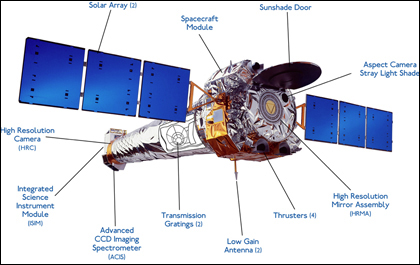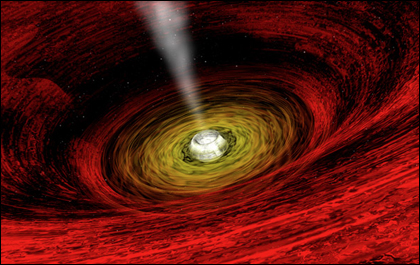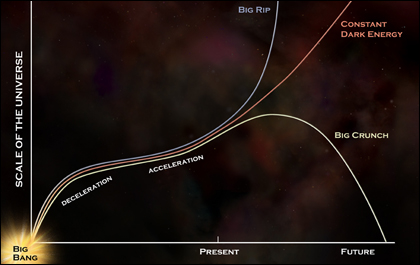-
Since its launch on July 23, 1999, the Chandra X-ray Observatory has been NASA's flagship mission for X-ray astronomy, taking its place in the fleet of "Great Observatories."
Who we are
NASA's Chandra X-ray Observatory is a telescope specially designed to detect X-ray emission from very hot regions of the Universe such as exploded stars, clusters of galaxies, and matter around black holes. Because X-rays are absorbed by Earth's atmosphere, Chandra must orbit above it, up to an altitude of 139,000 km (86,500 mi) in space. The Smithsonian's Astrophysical Observatory in Cambridge, MA, hosts the Chandra X-ray Center which operates the satellite, processes the data, and distributes it to scientists around the world for analysis. The Center maintains an extensive public web site about the science results and an education program.What we do
Chandra carries four very sensitive mirrors nested inside each other. The energetic X-rays strike the insides of the hollow shells and are focussed onto electronic detectors at the end of the 9.2- m (30-ft.) optical bench. Depending on which detector is used, very detailed images or spectra of the cosmic source can be made and analyzed.What we are excited about
Chandra has imaged the spectacular, glowing remains of exploded stars, and taken spectra showing the dispersal of elements. Chandra has observed the region around the supermassive black hole in the center of our Milky Way, and found black holes across the Universe. Chandra has traced the separation of dark matter from normal matter in the collision of galaxies in a cluster and is contributing to both dark matter and dark energy studies. As its mission continues, Chandra will continue to discover startling new science about our high-energy Universe. Follow us on Facebook and Twitter. More
Chandra's elliptical orbit takes the spacecraft to an altitude of approximately 139,000 km (86,500 mi) -- more than a third of the distance to the Moon. Find out the current position of Chandra in relation to the surface of the Earth from NASA/JPL's Eyes on the Solar System applet. Our Satellite Tracking Tutorial also shows you just what the Chandra orbit looks like.
Operating in space since 1999, Chandra detects and images X-ray sources that lie within our Solar System to those billions of light years away. The results from Chandra help explore high-energy phenomena and provide insights into the Universe's structure and evolution. More

Chandra
NASA's Chandra X-ray Observatory is a telescope specially designed to detect X-ray emission from very hot regions of the Universe such as exploded stars, clusters... More |
Milky Way
Today we know that the Milky Way is our home galaxy—a vast rotating spiral of gas, dust, and hundreds of billions of stars. The Sun and its planetary system formed... More |
Solar System
One Star, eight planets, and a myriad of moons, comets, and asteroids. This is the Earth's local neighborhood known as the Solar System... More |
Galaxies
There are billions of galaxies throughout the Universe and they come in different shapes and sizes. Within these galaxies are black holes, neutron stars, and... More |
Supernovas
Supernovas are some of the most dramatic events in the cosmos. These titanic events send shock waves rumbling through space and create giant bubbles of... More |
Galaxy Clusters
Galaxy clusters are the largest objects in the Universe held together by gravity. Chandra detects the superheated gas that fills the space between the hundreds and... More |
Black Holes
If a star has three times or more the mass of the Sun and collapses, it can form a black hole. These bizarre objects are found across the Universe -- within double... More |
Cosmology
Most of the Universe is dark. The protons, neutrons and electrons that make up the stars, planets and us represent only a small fraction of the mass and energy of... More |
- What is Chandra?
- What is an X-ray?
- What is Light?
- What is a Light year?
- What is a Black Hole?
- What is a Supernova?
- What is Dark Matter?
- What is Dark Energy?
The Observatory has three major parts: (1) the X-ray telescope, whose mirrors focus X-rays from celestial objects; (2) the science instruments which record the X-rays so that X-ray images can be produced and analyzed; and (3) the spacecraft, which provides the environment necessary for the telescope and the instruments to work.
Chandra's unusual orbit was achieved after deployment by a built-in propulsion system which boosted the observatory to a high Earth orbit. This orbit, which has the shape of an ellipse, takes the spacecraft more than a third of the way to the moon before returning to its closest approach to the Earth of 9,942 miles. More

A new form of radiation was discovered in 1895 by Wilhelm Roentgen, a German physicist. He called it X-radiation to denote its unknown nature. This mysterious radiation had the ability to pass through many materials that absorb visible light. X-rays also have the ability to knock electrons loose from atoms. Over the years these exceptional properties have made X-rays useful in many fields, such as medicine and research into the nature of the atom.
Eventually, X-rays were found to be another form of light. Light is the by-product of the constant jiggling, vibrating, hurly-burly of all matter. More

The word light usually makes one think of the colors of the rainbow or light from the Sun or a lamp. This light, however, is only one type of electromagnetic radiation. Electromagnetic radiation comes in a range of energies, known as the electromagnetic spectrum. The spectrum consists of radiation such as gamma rays, x-rays, ultraviolet, visible, infrared and radio.
Electromagnetic radiation travels in waves, just like waves in an ocean. The energy of the radiation depends on the distance between the crests (the highest points) of the waves, or the wavelength. In general the smaller the wavelength, the higher the energy of the radiation. More

In astronomy, distances are measured in units of light years, where one light year is the distance that light travels in a year—10 trillion kilometers. For historical reasons having to do with measuring distances to nearby stars, professional astronomers use the unit of parsecs, with one parsec being equal to 3.26 light years. More

A blackhole is a dense, compact object whose gravitational pull is so strong that - within a certain distance of it - nothing can escape, not even light.
If a star has three times or more the mass of the Sun and collapses, it can form a black hole. These bizarre objects are found across the Universe -- within double star systems and at the centers of galaxies where giant black holes grow. X-ray telescopes like Chandra can see superheated matter that is swirling toward the event horizon of a black hole. Chandra has revealed how black holes impact their environments, how they behave, and their role in helping shape the evolution of the cosmos. More

A supernova is the explosive death of a star, caused by the sudden onset of nuclear burning in a white dwarf star, or gravitational collapse of the core of massive star followed by a shock wave that disrupts the star.
Supernovas are some of the most dramatic events in the cosmos. These titanic events send shock waves rumbling through space and create giant bubbles of gas that have been superheated to millions of degrees. Chandra has captured supernovas and the remnants they've left behind in spectacular X-ray images, helping to determine the energy, composition, and dynamics of these celestial explosions. More

Dark matter is a term used to describe matter that can be inferred to exist from its gravitational effects, but does not emit or absorb detectable amounts of light.
The nature of dark matter is unknown. A substantial body of evidence indicates that it cannot be baryonic matter, i.e., protons and neutrons. The favored model is that dark matter is mostly composed of exotic particles formed when the universe was a fraction of a second old. Such particles, which would require an extension of the so-called Standard Model of elementary particle physics, could be WIMPs (weakly interacting massive particles), or axions, or sterile neutrinos. More

Dark energy is a hypothetical form of energy that permeates all space and exerts a negative pressure that causes the universe to expand at an ever-increasing rate.
At the close of the 20th century, our perception of the Universe was jolted. Instead of slowing down after the Big Bang, the expansion of the Universe was found to be accelerating. Was the cosmic acceleration due to Einstein's cosmological constant, a mysterious form of "dark energy," or perhaps a lack of understanding of gravity? The answer is still out there. By studying clusters of galaxies, X-ray astronomy is tackling this question using powerful techniques that are independent of other methods currently being employed or proposed for the future. More






















